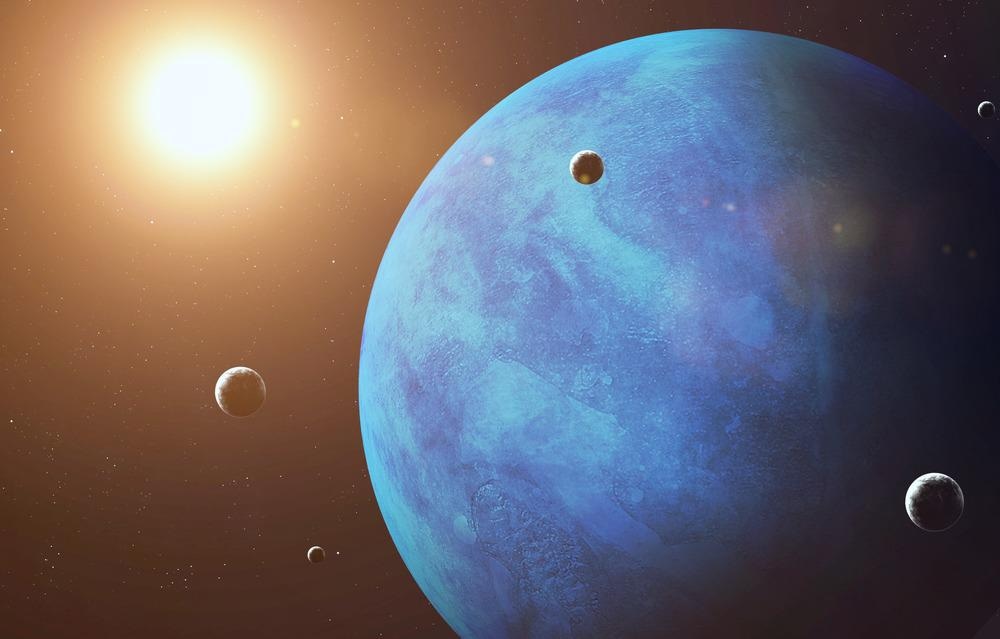A phase of water rarely seen before could explain mysteries surrounding the solar system’s ice giants, Neptune and Uranus.

Image Credit: Vadim Sadovski/Shutterstock.com
Researchers have discovered a new phase of water that forms at extremely high temperatures and pressures. The phase of water - which is possibly found at the center of ice worlds such as Neptune and Uranus - is called superionic ice.
Of course, everyone is familiar with the liquid, vapor, and ice phases of water, but what is less familiar is the fact that water can form over a dozen different structures. But at particularly high pressures, researchers predict that sublattices are created in superionic ices with highly mobile protons within the stable oxygen.
This is not the first time that superionic ice has been observed. In the past, it has only been looked at for a brief instance when researchers passed a shockwave through a droplet of water.
Verifying the existence of this form of water has been challenging for scientists with contradictory results emerging from both theory and experiment.
New research published in the journal Nature Physics describes how scientists used the U.S. Department of Energy’s Advanced Photon Source (APS) to laser-heat water in a diamond anvil cell, and high-pressure and high-temperature synchrotron X-ray diffraction to accurately map the properties of this new ice, which constitutes a new phase of matter.
Even University of Chicago researcher Vitali Prakapenka, lead author of the paper, was surprised that superionic ice was found at such low pressures.
What is clearer is that the research could help shed light on the interior conditions of the solar system’s ice giants, Neptune and Uranus. It could also explain the magnetic fields observed around these worlds.
We currently do not know where the solar system’s ice giants’ magnetic fields emerge from or why they are so strong. For example, Neptune’s magnetic field is at least 27 times more powerful than Earth’s magnetosphere.
Until now, researchers have suspected that the fluid layers of ice giants near their surfaces are the cause of these powerful magnetic fields. But these new findings regarding superionic ice could shake up that theory.
What is Superionic Ice?
The key to at least 18 known forms of water is the versatility of the hydrogen bonds that hold the two hydrogen atoms, and one oxygen atom that makes a water molecule together.
At high pressures, the bonds of traditional molecules shift, which results in hydrogen floating freely in an oxygen lattice. Because hydrogen atoms carry a charge, their mobility with this crystalline lattice allows this superionic ice to conduct electricity almost as well as metal.
Until now, the exact conditions at which these conditions emerge could not be agreed upon. Prakapenka and his colleagues used the APS — which can accelerate electrons to relativistic speeds close to that of light — to blast powerful X-rays through samples squeezed between pieces of diamond and heated with lasers. The way the X-rays scatter from the atoms in the sample shows the team how its atoms are arranged.
Discovering that removing the extreme heat and pressure and returning it to room conditions reverted the sample to its original state and they realized the change they had induced was phase related.
They then set about studying the structure and properties of this phase of water.
Researcher Prakapenka describes water as a cubic lattice with oxygen atoms at the corners connected by hydrogen. In the superionic phase, the lattice expands, allowing the hydrogen atoms to begin moving to generate a moving charge and a magnetic field.
While this is happening, the oxygen atoms are stable, creating, in effect, a solid oxygen lattice in an ocean of floating hydrogen atoms. This changes the qualities of the ice, which becomes less dense but significantly darker because it interacts differently with light.
The superionic phase emerged at pressures under half that which was previously believed to give rise to the phase.
The team found that two different conditions could give rise to two different types of superionic ice. Furthermore, they found that one of these sets of conditions resembles the internal atmospheres of Neptune and Uranus.
Beyond understanding the quirks of the ice giants, the findings could be important for investigations of life elsewhere in the Universe. This is because magnetic fields around planets are a vital element in protecting early cellular life from harsh radiation from their parent stars.
It is still early days for this investigation of the superionic ice phase, however. The researchers suggest that future investigations should probe this phase of matter’s conductivity and viscosity, as well as its chemical stability when it mixes with salts or other minerals found at the center of planets such as Earth.
References and Further Reading
Prakapenka, V.B., Holtgrewe, N., Lobanov, S.S. et al. (2021) Structure and properties of two superionic ice phases. Nat. Phys. 17, 1233–1238, https://doi.org/10.1038/s41567-021-01351-8
Disclaimer: The views expressed here are those of the author expressed in their private capacity and do not necessarily represent the views of AZoM.com Limited T/A AZoNetwork the owner and operator of this website. This disclaimer forms part of the Terms and conditions of use of this website.